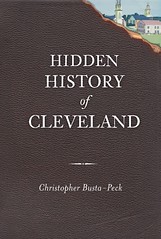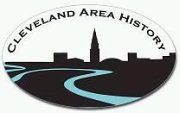
I've driven by this house, at 1618 Ansel Road, dozens of times on my way to and from work at the library. When I started at this job, a little more than a year ago, the windows weren't boarded up, but other than that, little has changed.
I was never quite comfortable with the house - visually, something just didn't seem quite right. One might attribute this to a merely average architect, but I suspected something more.
One resource available for Cuyahoga County residents seeking historic information about their houses are the property cards held in the County Archives. The property cards were created to document every house in the county for the purpose of tax valuation. There are two series - one created in the 1920s, which detail the amenities in greater detail and which include a basic footprint of the house, and a second series, created in the late 1950s and early 1960s, which feature a small (1.75"x2.5") photograph of each of the houses.
One day, after looking up some information about my own house at the County Archives, I began working on photographing some of the property card photos of the Hough area, using my camera on a tripod. The originals are relatively grainy and low-resolution, so I was able to record just about all of the information in the originals. This set represents the work of a couple hours that morning.
While I was working through the property card photos, I came across this image:

The number on the sign that the guy is holding is the individual parcel number. Since this information is included in the photograph, it means that the person digitizing these images in bulk doesn't need to record the rest of the information on the card, which might take a considerable amount of time. It is also very helpful for the many photographs that have become detached from their cards, as the glue has failed with time.
The roof was originally slate, as we can still see in some places. Unfortunately, the nails that hold asphalt shingles in place also poke holes through the underlying slate, so if a new owner wanted the roof to be slate again, they would have to rip off the existing slate and redo the roof.
On the front of the house, the columns have either been covered with aluminum or replaced with heavier, boxier ones. A window on the third floor has been covered by aluminum siding.
It's hard to make aluminum siding work on a round surface, like the tower. It's also hard to make a gutter fit around it, which was evident even in the photo taken in the 1950s.
On the side of the house, we can see that one of the windows has either been removed or covered with aluminum siding. The chimney, which seemed to be leaning even in the 1950s photograph, was removed to a point close to the roof line. The second floor window was replaced with one lacking the ornamental detail of the original. The tall, skinny window on the third floor was replaced with one lacking the same proportions. Finally, the screened-in porch in back was enclosed.
This is not meant as an exercise in the uglification of a house. Rather, it is an example of what sort of detail might be hiding under the aluminum siding of an otherwise bland seeming building. These houses were built at a time when labor was cheap - it's a heck of a lot of effort to keep up that detail - it would be difficult to convince me to spend the time to strip the paint on all the little details of a Victorian or Queen Anne.
The house was foreclosed on. It is currently owned by one Donald Gravois of 39672 Country Club Dr, Palmdale, CA 93551.
If you do go to the County Archives, don't just look for photographs of your house. Look for your neighbor's houses on either side - the photographs, especially in areas where the houses are closer together, will include a bit of the side of your house that probably isn't included in your house. You might also want to look at the rest of your block, to see if there's another house similar to yours from which you might gain inspiration. You might go so far as to look on the block behind yours - occasionally, a bit of your house might show up in the background.
There are many other resources for learning about historic houses in Cuyahoga County. In coming weeks, I will address others in detail.




I'd like to know that the County Archives contained hundreds of photos of my father or grandfather at work as a young man, even if it's hundreds of variations of him holding a PPN sign. Wonder if his know.
ReplyDeleteAbout the holes in slate roofs. It seems like such a waste to have to remove the slate. I wonder if someone has/could develop a durable product to patch those holes and that would not be visible from the ground as a patch. Some sort of exterior epoxy, perhaps.
ReplyDeleteBill - interesting idea. I wonder if there are records of all the people who worked on that project. Maybe they're even public.
ReplyDeleteKaren Anne - While I like that idea, it scares me. Around here, used slate that sizes costs about 75 cents each, in quantity. The idea of epoxying that many slates, which would probably require the removal of the slates above them, would barely be cost effective. Then there's the issue of leaks and the difficulty of locating them.
While I'd like to see the building retain a slate roof, with the amount of work that would be involved, I'd rather do a complete tear-off and redo the roof, which would allow me to fix the flashing and all that.
Great post! I've always wanted to learn more about my house and am looking forward to making a visit to the County Archives.
ReplyDeleteThanks! Be sure to let us know what you find!
ReplyDeleteglad i found your post about these house cards. i was so happy when i found them while researching at the county archives. i tell everyone about them. love yor post on the hough pictures.
ReplyDelete